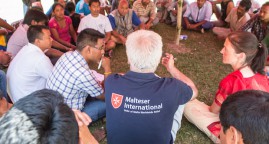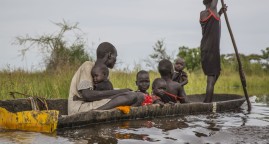Three humanitarian trends to watch in 2016
l through last year, civilians carried the weight of the world’s wars on their shoulders.
Syrians starved in besieged towns, Iraqis were subjected to staggering violence, Yemenis were battered by airstrikes, and tens of thousands of Central Africans were forced to flee their homes. With violence and destruction at such extreme levels, what future is there for the 16 million babies born into conflict in 2015?
Unfortunately, 2016 is likely to be just as unforgiving. Fighting will continue to take a massive toll on communities, as social, political and economic systems disintegrate and body counts rise ever higher. This is not inevitable, but the current political climate – or lack of political action – certainly does not bode well for civilians trying to survive in Syria, Yemen, Iraq, the Central African Republic or any other conflict for that matter.
National interests trump international law
The US bombing of a Médecins Sans Frontières (MSF) hospital in Kunduz, Afghanistan – causing the deaths of 42 patients and medical staff – was sadly not an isolated incident. Yemen and Syria have seen similar attacks. As MSF International President, Dr Joanne Liu put it, “Even war has rules” – and these attacks break all the rules.
All too often wars are not fought according to these rules, using direct attacks against civilians, indiscriminate attacks and starvation, “creating civilian suffering that involves serious violations of international humanitarian law.”
This failure, while extremely disappointing, was perhaps somewhat expected given the current political climate. All around the world, states involved in armed conflicts believe that national interests, whether expressed as national sovereignty or a global fight against extremism, trump any global accountability mechanism concerning the protection of civilians. This trend is not going away.
Aid agencies negotiate with extremist groups
As well as states playing major roles in conflicts in 2015, rebel groups, militias and self-defence groups also played a part. Convincing armed groups to give access to aid agencies so they can help those in need is vital to humanitarian response in conflict-affected areas. Successfully negotiating to gain such access is no mean feat, particularly when groups hold extremist ideologies.
Record numbers of refugees – and governments struggle to provide long-term support
Today’s wars have fuelled record levels of displacement. In 2014, more people fled from conflicts than at any point in time since World War II –a staggering 59.5 million people. Climate change, grinding poverty and natural disasters have driven even more people to leave their homes, communities and countries behind.
Negotiations pose reputational risks as well as the risk of breaching counter-terrorism legislation. Certain counter-terrorism measures are so expansive that they risk making assistance of civilians under the control of proscribed groups unlawful, resulting in a “chilling effect”, whereby humanitarian organisations are reluctant to engage in negotiations even though they are an essential part of humanitarian action.
So what does this all mean for the humanitarian sector? Aid can’t solve conflicts, but it is falling short of meeting the scale of needs around the world, through weaknesses of its own. The humanitarian system is desperately in need of a paradigm shift to be more effective, more inclusive, more flexibly financed and better able to meet people’s needs. Not just because the World Humanitarian Summit is around the corner, but because people affected by conflict depend on it.
Read the full article on ODI website
Related Articles
Nepalese earthquake: 6 months on, unrest and approaching winter worsen the situation
10/20/2015. In the six months following the earthquake, Malteser International was able to provide aid to 70,000 people. More than 10,000 families – around 62,000 people – were provided with staple foodstuffs, hygiene articles, tarpaulins, and toolkits, as well as given help to clear the rubble from their homes and villages.
When Food Shortage Becomes Famine
02/25/2016. More than 2.8 million people in South Sudan — nearly a quarter of the country’s population — are currently facing food shortages and need urgent assistance.
South Sudan: UN report contains “searing” account of killings, rapes and destruction
03/11/2016. UN report contains “searing” account of killings, rapes and destruction






